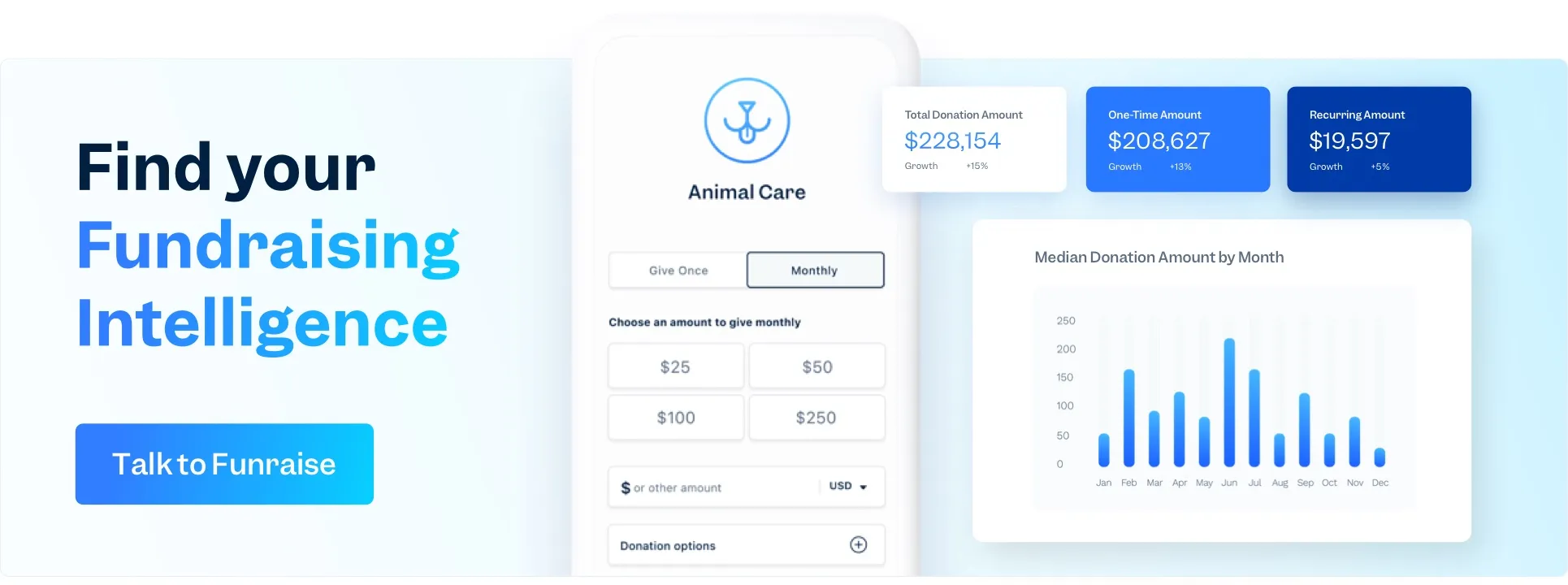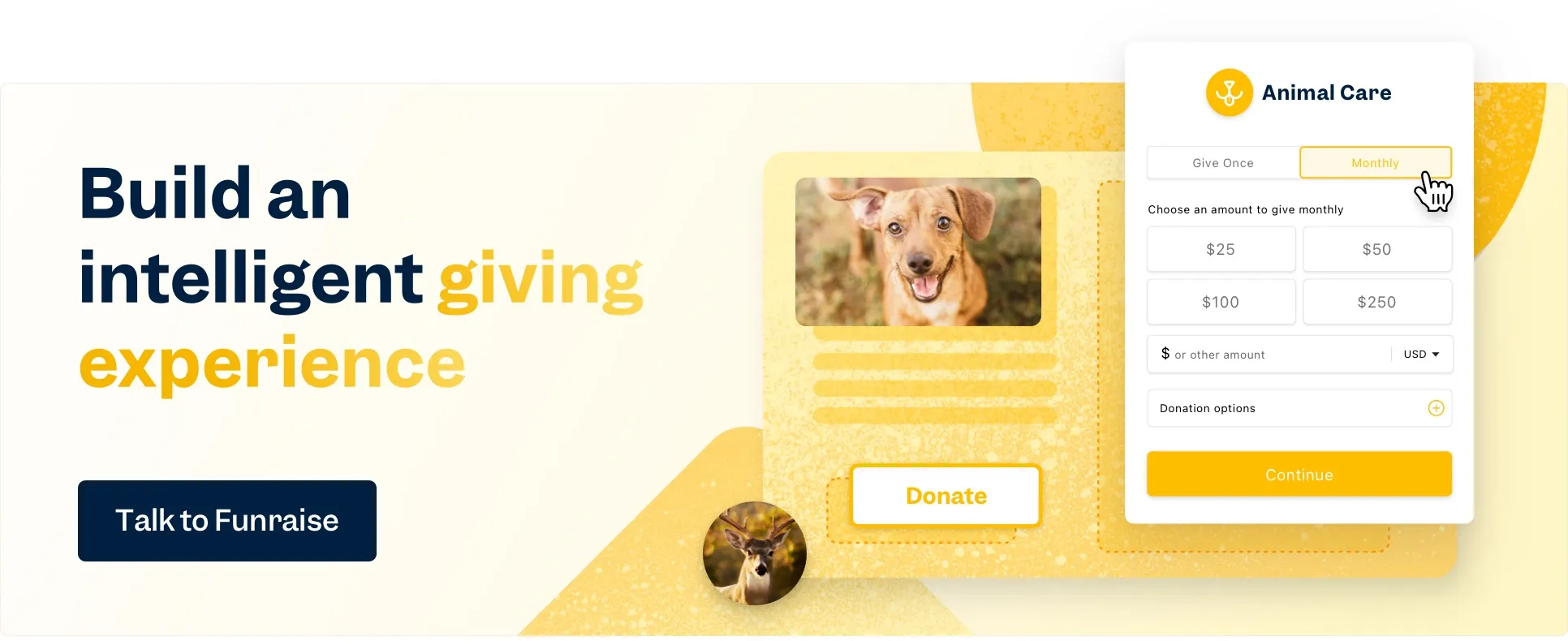The nonprofit sector has moved on from 2020 (sort of), and in case you haven't heard, times have changed. Things are kinda sorta all over the place—locally and globally, financially and politically. And when everything is changing quickly and unpredictably, it tends to get rocky professionally and personally, too.
So, as a nonprofit organization, how do you prepare for a recession? More specifically, how do your nonprofit leaders support your teams, volunteers, donors, and clients during turbulent times? Here are some people-centric suggestions on how to forge ahead with agility and resilience no matter what's going on in the world.
How to take care of your people
A lot of supporting people through turbulence comes down to fostering trusting and transparent managerial relationships. Turns out that staff, donors, volunteers, clients, and even executive directors actually have a lot in common—they're all people, and people like authenticity and connection.
Be transparent
Now is not the time to speak in vague generalities. Instead, keep it real with your people—and that goes for staff members, potential hires, volunteers, donors, and clients. By being open when it comes to recruiting new candidates, evaluating performance, and sharing company information, you'll build trust and boost morale.
Take care of yourself
It's a cliché for a reason: you have to take care of yourself before you can take of others. If you're feeling overwhelmed, exhausted, or anxious, you can't support your colleagues, clients, or volunteers. That means you need to do something about it. Talk to a professional, take a vacation, start meditating, or learn to crochet. Whatever works for you is the right thing to do.
Create safe spaces
A lot of places aren't conducive to authentic conversations—and yes, we're looking at you, open office plans. Ensure everyone at your nonprofit, from staff members to major donors to clients, has a safe space in which to discuss their hopes and fears. Then, listen with empathy and understanding.
Be there in person
We love a flexible workplace, but some conversations need to happen face to face. If you're delivering difficult news, having an emotional conversation, or working through a big decision, try to have it in person. If it's a video chat, have everyone brew the same coconut latte to make things a bit more intimate.
But keep some things light
In times of stress—and in times of remote working—chill water-cooler conversations tend to fall by the wayside. Don't let them! One way to support people is to make a genuine connection through some old-fashioned small talk. Personally, we recommend a Slack channel for pics of dogs dressed as celebrities and another for feminist fantasy book recommendations.
Ask questions
Not everyone's going to be an open book when it comes to how they're dealing with this vicious news cycle of ours. That means it's up to you to ask your individual donors how things are going or ask your clients what they need. A simple, “How are you feeling?” or “Can I do anything to support you?” goes a long way.
Focus on impact
During challenging times, a lot of us struggle with feeling powerless. But by emphasizing community impact, you can lift people's spirits and motivate them to keep fighting the good fight.
How to motivate your staff
Because of factors like inflation and the charged political arena, the job market is much different than it was just a few years ago, and both employees and businesses may be experiencing a range of feelings which can lead to difficulty focusing, distracted working, or stressed spiraling. With these changes in the market, many businesses have become aware of the importance of valuing and supporting their employees through tough times.
If you want to retain talent and motivate your people through the ups and downs of life, you need to be flexible and listen well. Tiffany Keesey, Co-founder and Principal Consultant at Conscious Culture, gives even more of a reason for nonprofits to prioritize retention:
...investing in your people, you really can never go wrong. And I think if you're trying to make that case, you can look at some of the stats around, like, what's it going to cost us if we don't bring in someone incredible for this role? Like, what's the downside there and what is the cost of turnover? It costs up to 70% to fill a position, 70% of a person's annual salary, which is amazing. But if you think about it like the month of the role of open, like the hours you spend recruiting and interviewing and the hours you spend training and institutional knowledge... so if we're able to take a longer term approach to investing more into comp and benefits, gets us those A players but also helps us retain them, it's going to have exponential ROI and really save costs in the long run.
Provide remote options
Like it or not, we now live in a hybrid world, and many people are happier for it. If your staff members like working remotely and are still getting their work done (and done well), don't force them to return to the office five days a week. People are finally getting their laundry done in a timely manner! This is one benefit that costs you nothing and can really reduce stress and improve quality of life.
Make a plan
If we'd had a better plan in place, 2020 might've looked a whole lot better, and the same is true for leading through any crisis. Meet with your team leadership or executive director to brainstorm ideas for various possibilities. Then, write ‘em up so that everyone's on the same page. You might not know exactly what's going to happen, but you'll have a jumping-off point to support your people, and that's something.
Offer flexible hours
Life happens, and we have to prioritize it. Rather than having everyone work from 8-5 with a one-hour lunch break, find out what each individual prefers. Then, work with them to develop a schedule that has some overlap but accommodates school drop-offs, dog walks, and sleep schedules.
Provide benefits that help
It's all well and good to tell stressed-out team members to exercise and eat well to improve their mental health, but if you're asking them to put in 50-hour weeks and the kitchen is stocked with coffee and Diet Coke, you're not walking the walk. Offer mandatory, paid mental health days. Buy some granola bars from the local bakery. Find a volunteer to lead a weekly stretching session during work hours.
Celebrate the wins
Nonprofit life moves fast, and it's easy to feel that the to-do list is constantly growing. But no matter how busy you are, it's important to celebrate your accomplishments. If someone gets promoted, get them a coffee. After a big fundraising event, take the team out to frolic with some baby goats.
How to retain your volunteers
Volunteers are pretty dang amazing, offering up their time and talents to make the world a better place without charging a cent. When the going gets tough, it can be hard to attract and retain volunteers, who may find themselves short on time and drawn in a hundred different directions. But with a great partnership like Funraise and POINT, you can help them stick around through the ups and downs of life.
Provide an awesome volunteer experience
There are tons of volunteer management software solutions on the market, but there's a reason Funraise picked POINT as our partner. POINT makes it easy for volunteers at any level of tech fluency to sign up, provide information, and even volunteer with friends. Include Funraise in the mix, and you've got the best donor-to-volunteer-to-donor ecosystem in the nonprofitsphere.
Offer online opportunities
Just like staff members, not all volunteers want to commute these days—but many still want to help. Given how much of our day-to-day happens online, most organizations can provide opportunities to give back no matter where your volunteers happen to be located. So, get creative and take advantage of tech-savvy talent with some time on their hands.
Ask for feedback
Volunteer recruitment is a full-time job (literally), but it's hard to know what's working and what's not from the outside. If you want to support your volunteers, ask them what they need. You could schedule one-on-one check-ins, or you could save some time by sending out a survey.
Offer short-term positions
When someone can commit to volunteering weekly, same time, same place, for the next two decades, you've hit the volunteer jackpot. But given all the uncertainty of the past few years, it's also okay to meet people where they are. Offering short-term volunteer positions is one way to support everyone who wants to support you—even if they have a lot going on.
Be crystal clear
When times are uncertain, no one wants to spend their time unsure of what they're doing. Tighten up your volunteer onboarding, provide training, and clarify your policies to ensure everyone comes to work ready to hit the ground running and make a real difference.
Say thank you (in many ways, repeatedly)
When people don't feel appreciated, they don't do their best work, and often, they leave. Make sure your volunteers know how much you love and appreciate them. Say thank you, write notes that say thank you, and do tiny acts that say thank you. Hold regular appreciation events, and bring them that double-iced peppermint mocha on occasion.
Appreciate boundaries
Just like staff members, volunteers can burn out—and given that you're getting free, much-needed help, it's easy to ask, and ask, and ask, until suddenly, your volunteer is no more. Encourage volunteers to take care of themselves and leave on time.
How to engage with your donors
There are reams and volumes written and spoken and probably sung about building relationships with all your donors—from major donors to potential donors—in a million ways and in all sorts of situations. Before you add this to the mountain of advice out there, look at these suggestions from a lens of stability, simplicity, and certainty.
Provide flexible giving options
When times are uncertain, finances follow suit. Stock markets go up and down, people retire early, etc., etc. As a result, you're bound to see some changes in giving patterns. Be understanding and provide flexible options so that donors can contribute even when their financial situation changes. For example, you can educate them on planned giving, advertise corporate matching, or facilitate tax savings through stock gifting.
And offer options besides financial giving
In an economic downturn, some donors will stop donating—but no recession lasts forever. Keep the giving going and the donor relationships strong by offering other ways to get involved, like volunteering or running peer-to-peer fundraisers.
Get personal
No one ever wants to be reduced to a number, but that's especially true when budgets are tight and times are uncertain. Invest in retention by getting to know your current donors and personalizing all your communications. When donors feel seen as individuals, they're much more likely to stick around—no matter what.
Focus on the now
How are current conditions directly impacting the people you help? That's what your donors care about. Flex your storytelling muscles and your personal relationships with donors to educate them on how the current times are affecting your work; then, tell them how they can help. Urgency is a powerful motivator.
Share the impact
As Nuka Solomon, CEO of Free Wheelchair Mission, said on the Nonstop Nonprofit podcast, says, sharing impact means also sharing the burden:
"If your donors have not experienced losing their mobility or don't live in a hut in a very arid or very wet region of the world, they may not understand why it's so critical to give something like a wheelchair. ...so sharing stories, sharing videos, sharing photography is very, very important to your mission."
Supporting your community during a recession: Key takeaways
- During challenging times, it's important to tailor your communications and interactions with staff, volunteers, donors, and clients alike.
- Meet uncertainty with transparency and authenticity. It builds trust and engenders loyalty.
- With staff members and volunteers, offer flexibility and empathy to retain them during tough times.
- With donors, show your appreciation, personalize your approach, and offer flexible giving options.
How to prepare for a recession in 2025: Key takeaways
As your nonprofit prepares for a recession, steps to take are to take stock of the resources you already have, your predictable income, and your predictable expenses. Do not panic. Consider ways to keep your employees on, to expand your community and network, and to increase programming; for example, maybe you can join forces with another nonprofit.
- In an ideal world, nonprofits would have the "pre" part of "prepare" done and dusted. But, being the passion-filled folks that we are, don't feel bad if you're preparing on the fly.
- Math is your friend. Do some calculations to see what it may look like if your income stays the same but your expenses go up by 10%, 20%, etc, if your resources are cut off, or if your income goes down. Or all three.
- Remember that this is largely out of your control. If you could control things, your vision would already be achieved, right? Continue pursuing your mission and building the world you want to see.
- Do not give in to the scarcity mindset. Keep your team intact if at all possible, and be open to ways that you can increase your offerings rather than hoarding or contracting your programming.































.webp)
.webp)











.webp)
.webp)

.webp)
.webp)
.webp)




